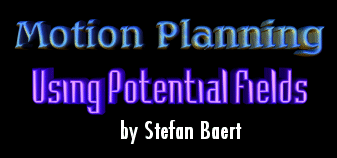11/10 - 11/12 @ Montréal, Canada
12/5 - 12/7 @ Shanghai, China
12/24 - 12/27
2/28 - 3/4 @ San Francisco, CA
More events...
2406 articles in the reference section.
Help us fight cancer!
Join SETI Team GDNet!

|
Technique 4 : Get away from the edgesSince we began our exploration of the potential field, we've learnt to get out of minima and even to ban them completely. But you'll have noticed in the last screenshot that we were moving dangerously close to the edge of objects and walls. In an environment where we might only know an approximate location of objects it would be best to stay as far away from them as possible to avoid collisions. For this we need to enhance our algorithm from the previous technique. Instead of initiating one wavefront in the destination, we will now start a wavefront in every pixel that is on the edge of an object. Each of these 'edge-pixels' gets a unique ID and gives this ID to all his direct neighbors. When two ID's that are sufficiently different collide we've found the middle between two close objects. The result will be a kind of Voronoi diagram between the objects which we can use as roadmap to navigate between the objects. All we then have to do is give the pixels in the grid that do not belong to this roadmap, a value so that our unit will get on the roadmap as soon as possible. For this we can use one of the techniques above.
The picture shows wavefronts coming from the edges of the objects and a purple roadmap exactly in the middle between several objects. ConclusionThis concludes our voyage using potential fields. The techniques described above are an interesting alternative for the A* algorithm that seems to be very popular these days. Though potential fields require some serious calculations to be applied their characteristic of defining a whole grid in numbers can be an asset if you need quickly changing destination goals, because all you need to do is increase or decrease the numbers in a certain region to make it more attractive (or not) for the unit to follow that path. |
|||||||||||